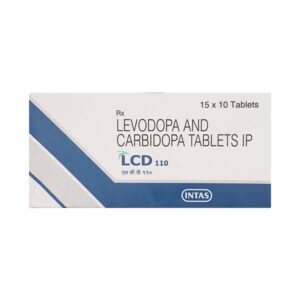CARBIDOPA + LEVODOPA
Carbidopa: Carbidopa is a medication primarily used in combination with levodopa to treat the symptoms of Parkinson’s disease. It is classified as a decarboxylase inhibitor.
Carbidopa works by inhibiting the action of the enzyme called aromatic L-amino-acid decarboxylase (AADC), which converts levodopa into dopamine in peripheral tissues outside the brain. This inhibition allows more levodopa to reach the brain and be converted into dopamine, which helps to alleviate the symptoms of Parkinson’s disease.
The typical dose of carbidopa is 25mg to 100mg taken orally three to four times a day in combination with levodopa. The exact dosage may vary depending on individual needs and response to treatment.
Common side effects of carbidopa include nausea, vomiting, dizziness, drowsiness, headache, constipation, dry mouth, and muscle stiffness. These side effects are usually mild and may diminish over time as the body adjusts to the medication. However, if these side effects persist or worsen, it is essential to consult a healthcare professional.
In some cases, carbidopa may also cause more serious side effects such as hallucinations, confusion, difficulty urinating, irregular or rapid heartbeat, and allergic reactions. These side effects should be immediately reported to a doctor.
It is important to note that carbidopa is always used in combination with levodopa and should never be taken alone. It is crucial to follow the prescribed dosage and timing instructions provided by a healthcare professional for the most effective and safe treatment of Parkinson’s disease symptoms.
Levodopa: Levodopa, also known as L-DOPA, is a medication commonly used in the treatment of Parkinson’s disease. It is a precursor of the neurotransmitter dopamine and is converted into dopamine in the brain. Levodopa is often combined with another medication called carbidopa, which helps prevent the breakdown of levodopa before it reaches the brain.
The mechanism of action of levodopa involves increasing the levels of dopamine in the brain. In Parkinson’s disease, there is a deficiency of dopamine due to the degeneration of dopaminergic neurons. By increasing dopamine levels, levodopa helps to alleviate the motor symptoms associated with Parkinson’s disease, such as tremors, rigidity, and bradykinesia (slowness of movement).
Levodopa is usually taken orally and is available in various forms, including immediate-release tablets, orally disintegrating tablets, and extended-release capsules. The dose and dosing frequency vary depending on the individual patient and the severity of their symptoms. However, a typical starting dose is usually around 100 mg two to three times a day, and the dose is gradually increased as necessary.
While levodopa is effective in managing the symptoms of Parkinson’s disease, it may also cause several side effects. Common side effects include nausea, vomiting, loss of appetite, dizziness, and drowsiness. Some patients may experience dyskinesias, which are involuntary movements, especially with long-term use of the medication. Other less common side effects can include hallucinations, confusion, orthostatic hypotension (a drop in blood pressure upon standing), and behavioral changes.
It is essential to note that levodopa may become less effective over time, and some patients may experience a phenomenon called “wearing off,” where the motor symptoms of Parkinson’s disease return before the next dose is due. In such cases, the doctor may adjust the dose or add additional medications to manage the symptoms more effectively.
Levodopa is a very effective medication for managing the symptoms of Parkinson’s disease, and while it may cause side effects, the benefits often outweigh the risks. Patients should discuss any concerns or potential side effects with their healthcare provider to ensure proper management of their condition.

